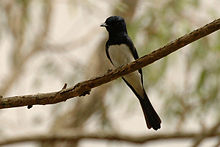Satin flycatcher
| Satin flycatcher | |
|---|---|

| |
| Scientific classification | |
| Kingdom: | |
| Phylum: | |
| Class: | |
| Order: | |
| Family: | |
| Genus: | |
| Species: | M. cyanoleuca
|
| Binomial name | |
| Myiagra cyanoleuca (Vieillot, 1818)
| |
| Synonyms | |
| |
The satin flycatcher (Myiagra cyanoleuca) is a species of bird in the family Monarchidae.
Taxonomy and systematics
The satin flycatcher was originally described in the genus Platyrhynchos. Alternate names include satin Myiagra and satin Myiagra-flycatcher.
Distribution
The satin flycatcher is found in Australia, Indonesia, and Papua New Guinea. Its natural habitats are temperate forests and subtropical or tropical moist lowland forests.
Description
Males are dark grey on their beak, eyes, legs and upper body with a white lower body. Females differ from males by having a more grayish upper body and light orange around their throat.
Breeding
The satin flycatcher breeds from October - February. 2 or 3 greenish blue with brown spotted eggs will be laid in a neat nest made of bark, spider's web and moss on a branch 5 – 25 m high.
References
- ^ BirdLife International (2017). "Myiagra cyanoleuca". The IUCN Red List of Threatened Species. 2017. IUCN: e.T22707403A118760627. doi:10.2305/IUCN.UK.2017-3.RLTS.T22707403A118760627.en. Retrieved 15 January 2018.
- Satin Flycatcher. arthurgrosset.com

